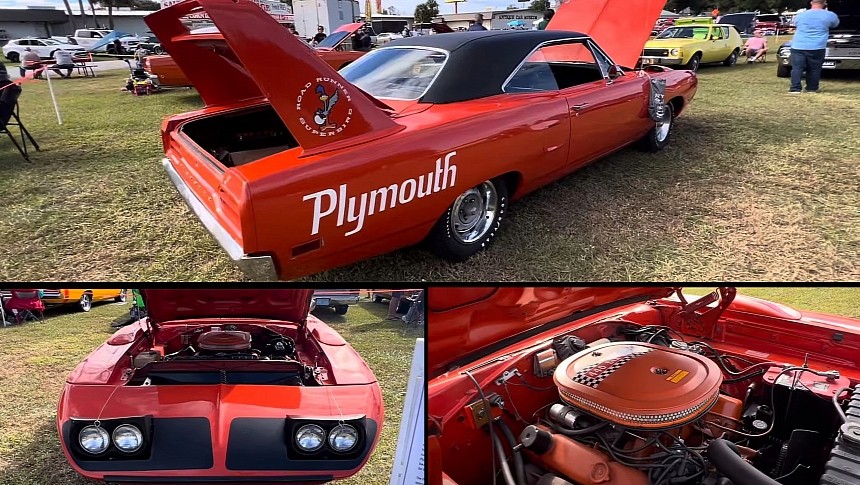Introduced in 1970, the Superbird was Plymouth's take on the Charger Daytona that Dodge launched in 1969. Essentially identical to its Dodge sibling, the Superbird was also released as a homologation special to help Plymouth race the "winged warrior" on NASCAR tracks.
In addition to a few cosmetic changes, the Superbird also got a third engine. The base 440-cubic-inch (7.2-liter) RB and the optional 426-cubic-inch (7.0-liter) HEMI were joined by a six-barrel variant for the former.
But while the Charger Daytona was a big hit and Dodge sold all 503 units almost immediately, Superbirds ended up sitting for several months on showroom floors. Word has it some examples were sold as late as 1972 and some were converted to Road Runner specs. All told, the Superbird is a lot more common at nearly 2,000 units built.
That's one of the reasons why it's not yet as valuable as the Daytona. However, the HEMI Superbirds are slowly moving into million-dollar territory, catching up on their Dodge counterparts. The 440 cars aren't there yet, but unrestored survivors are highly sought after and can fetch more than $400,000 at public auctions. The Tor Red example you see here is one of those cars.
Spotted at the 2023 Mopars With Big Daddy show, this Superbird is as original as they get as far as drivetrain components and body panels go. The 440-cubic-inch Six-Barrel V8 is numbers-matching, as is the automatic transmission with the column shifter. And even though it hasn't been restored since it left the assembly line more than 50 years ago, this Mopar still looks the part.
But the car hides one tiny secret: the Tor Red paint got a refresh a few years ago. Yes, we could argue that it's not a true-blue survivor, but it's definitely the next best thing since everything else is authentic.
This Superbird is also a rare gem. While not quite as scarce as a HEMI, of which only 135 units were made, this "winged warrior" is one of only 716 that got the six-barrel version of the 440 big-block V8. This carburetor setup increased output by 15 horsepower compared to the four-barrel variant. Specifically, the six-barrel came with 390 horses on tap.
The automatic transmission narrows the production status of this Superbird to one of 408 units made. Unfortunately, there's no official data on how many rigs got the column-mounted shifter and the standard bench seat, like this one did.
The Tor Red paint also makes it rarer than the average Superbird. Again, Chrysler didn't keep track of production by color, but Mopar expert Galen Govier put together a reasonable estimate based on his vast registry. According to him, only 14% of all Superbirds were ordered in this hue.
While it's not statistically correct, this could mean that only 57 Superbirds were ordered with the 440 Six-Barrel/automatic combo and a Tor Red exterior. But regardless of how rare it is, this Superbird is a stunning example that's still being driven after more than 50 years, which is spectacular, to say the least. Check it out in the video below.
But while the Charger Daytona was a big hit and Dodge sold all 503 units almost immediately, Superbirds ended up sitting for several months on showroom floors. Word has it some examples were sold as late as 1972 and some were converted to Road Runner specs. All told, the Superbird is a lot more common at nearly 2,000 units built.
That's one of the reasons why it's not yet as valuable as the Daytona. However, the HEMI Superbirds are slowly moving into million-dollar territory, catching up on their Dodge counterparts. The 440 cars aren't there yet, but unrestored survivors are highly sought after and can fetch more than $400,000 at public auctions. The Tor Red example you see here is one of those cars.
Spotted at the 2023 Mopars With Big Daddy show, this Superbird is as original as they get as far as drivetrain components and body panels go. The 440-cubic-inch Six-Barrel V8 is numbers-matching, as is the automatic transmission with the column shifter. And even though it hasn't been restored since it left the assembly line more than 50 years ago, this Mopar still looks the part.
But the car hides one tiny secret: the Tor Red paint got a refresh a few years ago. Yes, we could argue that it's not a true-blue survivor, but it's definitely the next best thing since everything else is authentic.
This Superbird is also a rare gem. While not quite as scarce as a HEMI, of which only 135 units were made, this "winged warrior" is one of only 716 that got the six-barrel version of the 440 big-block V8. This carburetor setup increased output by 15 horsepower compared to the four-barrel variant. Specifically, the six-barrel came with 390 horses on tap.
The automatic transmission narrows the production status of this Superbird to one of 408 units made. Unfortunately, there's no official data on how many rigs got the column-mounted shifter and the standard bench seat, like this one did.
The Tor Red paint also makes it rarer than the average Superbird. Again, Chrysler didn't keep track of production by color, but Mopar expert Galen Govier put together a reasonable estimate based on his vast registry. According to him, only 14% of all Superbirds were ordered in this hue.
While it's not statistically correct, this could mean that only 57 Superbirds were ordered with the 440 Six-Barrel/automatic combo and a Tor Red exterior. But regardless of how rare it is, this Superbird is a stunning example that's still being driven after more than 50 years, which is spectacular, to say the least. Check it out in the video below.











